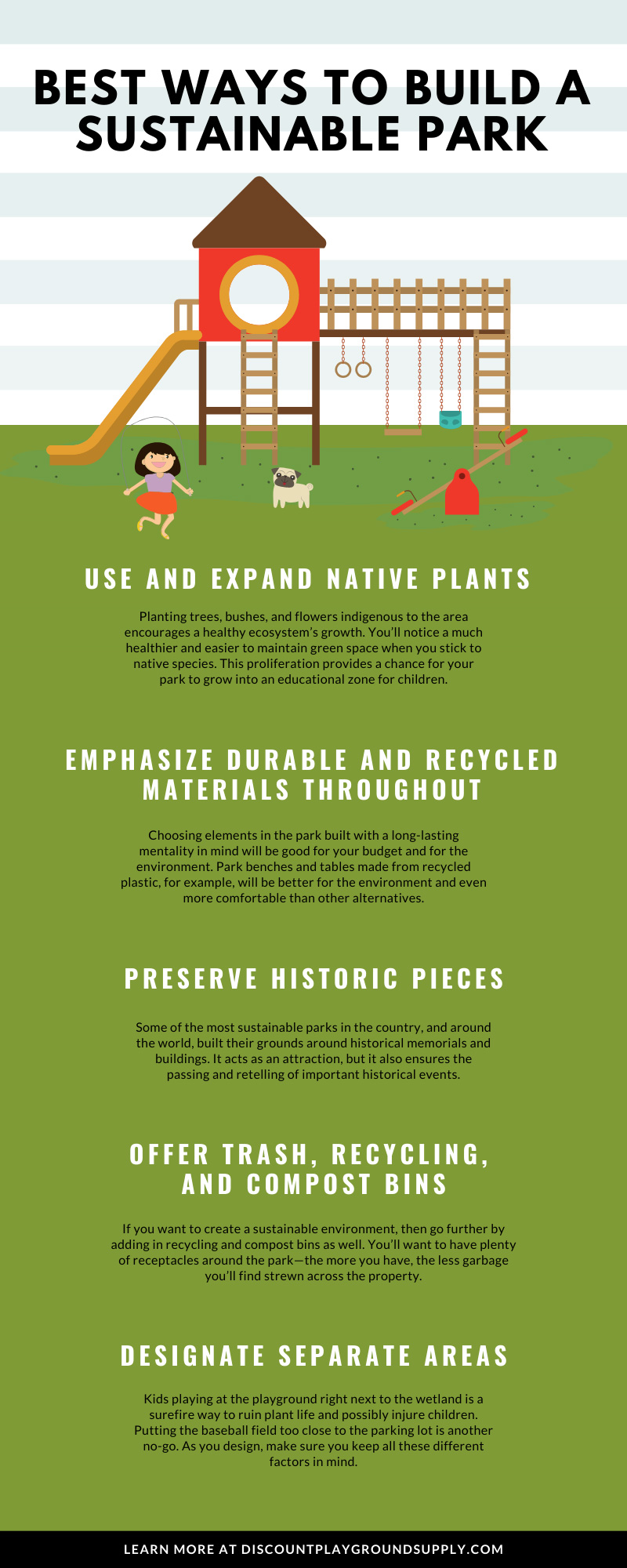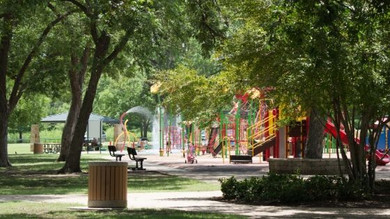
In many of our blogs, we discuss how important parks are to cities, children, the general population, and the environment. All these different groups benefit from these parks, playgrounds, and green spaces in different ways. Generally speaking, parks provide more than a beautiful space that enhance the community. In fact, parks preserve and protect natural areas, support healthy ecosystems, and provide a much-needed reprieve from the constant presence of unhealthy toxins for the planet.
That said, some parks and green spaces don’t get that quite right, as not all parks are built with the same care and protection. To put it simply, they aren’t as sustainable as we could make them. In one of our previous posts, we talked about some of the elements of a successful public park, and for a lot of people successful equals aesthetically pleasing. Though important, there is so much more to this green space than simply being pleasing to the eye.
An eco-friendly park does more than set our sights on something beautiful. It furthers that by offering a space that bolsters the environment and helps the native greenery and landscape. Building a park should not reduce the number of native species and animals; instead, a sustainable park should be a refuge for those specimens, giving them the opportunity to flourish. If you think your local park is detracting from the environment, rather than supporting it, take a look at some of the best ways to build a sustainable park. You’ll find that these changes make quite the impact on your green space’s overall beauty—implement some of these changes now!
Use and Expand Native Plants
Probably one of the easiest ways to create an eco-friendlier park is by expanding the native plants in the area. Planting trees, bushes, and flowers indigenous to the area encourages a healthy ecosystem’s growth. You’ll notice a much healthier and easier to maintain green space when you stick to native species. Better yet, these native plants create a habitat for diverse wildlife. This proliferation provides a chance for your park to grow into an educational zone for children. Providing tours to see these species is a wonderful way to draw people into your space and can increase the mental health benefits parks offer.
Emphasize Durable and Recycled Materials Throughout
Another fantastic way to build a more sustainable park is by thinking about the sort of materials you use. Choosing elements in the park built with a long-lasting mentality in mind will be good for your budget and for the environment. Park benches and tables made from recycled plastic, for example, will be better for the environment and even more comfortable than other alternatives. Even materials like rubber flooring are beneficial not only because of sustainability but for safety reasons, too. In any areas possible, choose durable, recycled materials over other options.
Preserve Historic Pieces
Nobody likes a park that tears down everything historical and natural to the area, so make sure you don’t do that. Some of the most sustainable parks in the country, and around the world, built their grounds around historical memorials and buildings. It acts as an attraction, but it also ensures the passing and retelling of important historical events.
Pushing further, you could also think about maintaining other historic features. Apart from memorials, buildings, and statues, you could also make more sustainable choices simply by preserving historic pieces around the park. Railings, cast-iron lamps, old benches, and the like can all be maintained or revamped while preserving their historical significance.
Offer Trash, Recycling, and Compost Bins
A simple fix, but an absolute necessity—trash bins are crucial to any park. If you want to create a sustainable environment, then go further by adding in recycling and compost bins as well. You’ll want to have plenty of receptacles around the park—the more you have, the less garbage you’ll find strewn across the property. Trash and recycling cans are a must, but if you truly want to make your park sustainable, then add a bin for composting as well (make it an educational moment and include information on how and what people can compost).
Keep as Much Existing Landscaping as Possible
Park builders should also aim to ensure that as much of the existing landscape is left undisturbed. For example, keep construction away from wetlands and other large expanses of natural greenery. Even building near wetlands can cause irreparable damage to them, so retaining the integrity of the landscape will be better for the environment. You just want to make enhancements to the area, so parkgoers get the opportunity to experience this beauty.
Fertilize with Mulch and Compost
Remember that compost bin we talked about earlier? Well now is your chance to use this effortless sustainability practice that could save you loads of money. Using natural fertilizers, such as recycled mulch and compost, feed the plants and trees better than any chemical fertilizer could. Not to mention it’s better for the diverse wildlife the park will bring in. Take those compost bins and make the most of them. As another learning opportunity for kids, show them the process of how a compost bin creates nutrient-rich food for the plants.
Designate Separate Areas
Our last tip for a sustainable and eco-friendly park delves into the various areas you include within it. Kids playing at the playground right next to the wetland is a surefire way to ruin plant life and possibly injure children. Putting the baseball field too close to the parking lot is another no-go. As you design, make sure you keep all these different factors in mind. Keep nature separate from the boisterous playground—it will keep the general nature exploration calmer and ensures plant and wildlife safety.
Follow these tips and you’ll surely create a sustainable haven for both plant life, wildlife, and pedestrians. For all things park and playground design related, turn to Discount Playground Supply. We have everything you need to create the eco-friendly park of your dreams. From park and playground trash cans and recycling bins to recycled benches and field equipment, we’ll make sure you get the most out of your park. Reach out now and see what a wonderful nature refuge you can create!


